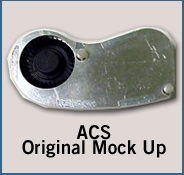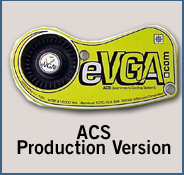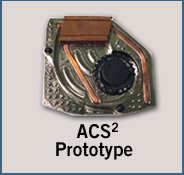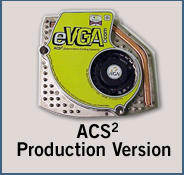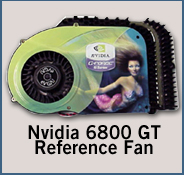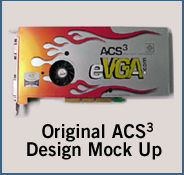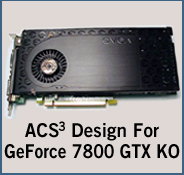
|
ACS (Asymmetric Cooling System) HISTORY
2/6/2002 ACS Available for GeForce MX 440 Introduced 3/1/2002 ACS² Available for GeForce 4400/4600 Ti Introduced 12/30/2003 U.S. Pat. No. 6,671,177 Awarded for ACS³ 8/1/2005 ACS³ Available for EVGA e-GeForce 7800 GTX KO Edition ACS
Remember the GeForce MX 440? Wow. It's been almost three and a half years now. Back then was when EVGA first introduced ACS (Asymmetric Cooling System), it was the first serious attempt to improve the way cooling devices for video cards were made and employed.
Conventional heat sink/fan units relied on a system whereby the fan was set directly on top of the heat sink, which in turn was affixed directly on top of the video card GPU. There are two problems with this method: 1, this arrangement hardly allows for the most efficient air flow, limiting its usefulness by continually recirculating hot air; and 2, this arrangement exposes the fan directly to high amounts of heat that can, over time, allow the GPU to act like an oven that simply cooks the fan until all of its lubrication is dried up and it becomes useless.
ACS was designed in a much more efficient manner; with a much larger heat sink with far more surface area to allow for much better heat dissipation; and the fan was placed off center from the GPU so as to allow it to be better protected from extreme temperatures and to allow it to create a much more efficient air flow through the entire unit. Both of these factors combined to make ACS one of the best cooling solutions ever made for the GeForce4 MX440 line of graphics cards; with the ACS being able to cool a GPU down to 39C from a stock temperature of 45�C.
ACS²
EVGA's next effort was ACS� - a revolutionary design idea that was built to support the Ti 4400 and Ti 4600 line of graphics cards. ACS� had to meet a number of new challenges that included both GPUs that were getting hotter than ever, and memory whose temperatures were steadily increasing. To accomplish this, ACS� kept the offset fan that is central to the ACS design philosophy while at the same time enlarging the heat sink to cover not only the GPU, but the memory as well. Added to that were three copper heat pipes (Had you ever heard of heat pipes in a desktop computer prior to EVGA introducing it?) that helped to quickly move heat away from the card's memory and GPU and into a large copper thermal baffle. This represented the first use of heat pipe technology in a desktop computer; and allowed the ACS� to be so efficient that it was able to see a 10% decrease in memory temperatures and a 15% decrease in GPU temperatures as compared to the reference cooling system. The end effect was both an increase in system performance and in product longevity.
If you happen to still have a Ti 4400 or a Ti 4600, take a look at it - notice that it doesn't have much in the way of retention holes the way more modern cards do? You might be pretty surprised to see how EVGA even managed to mount the ACS� to those cards with only two available holes (that were definitely not intended for something as big as the ACS�). That was a big challenge and a big learning experience back then, we were just starting to come up with things that just a few years later would become standards (heat pipes, etc.). We even can remember one review site that called the ACS� "lame" at the time - we launched it anyway, and now not to many people think that the technology is too lame.
After the success of ACS�, many others began to try and copy EVGA's success - and the market became flooded by a wave of customized cooling solutions. While imitation is the sincerest form of flattery, EVGA didn't want to be one of the pack, and we went back to work on ACS� - a cooling solution so unique and forward thinking that we were awarded a patent for its design (U.S. Pat. No. 6,671,177).
NVIDIA Reference Design
During the time of the 6800 line of cards, we held back on releasing the ACS� for a number of reasons. The most compelling being that the double-wide reference coolers specified by NVIDIA were quite excellent - thanks in great part to the fact that they borrowed heavily from earlier ACS design ideas such as: a large offset fan, big copper heat sink, and heat pipe technology.
ACS³
The new ACS� design not only derives itself from the original asymmetrical fan design, but combines an eye to the cosmetic, large heat sinks like found in the earlier designs, heat pipes, and new materials technology to dissipate heat at a whole new level. With the release of the 7800 line of cards, and the market's requirement for smaller cooling solutions, it is now the perfect time to unveil the new ACS�. Based on our ACS� technology, our e-GeForce 7800 GTX KO Edition is the only card in the marketplace that can operate at 490+/1300+ with real stability and confidence.
And, just like before, it won't take very long before you see all the copycats in the market showing up all over again.
